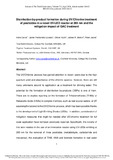JavaScript is disabled for your browser. Some features of this site may not work without it.
| dc.contributor.author | Carra, Irene | |
| dc.contributor.author | Lozano, Javier Fernandez | |
| dc.contributor.author | Autin, Olivier | |
| dc.contributor.author | Bolton, James R. | |
| dc.contributor.author | Jarvis, Peter | |
| dc.date.accessioned | 2020-01-16T10:45:27Z | |
| dc.date.available | 2020-01-16T10:45:27Z | |
| dc.date.issued | 2020-01-07 | |
| dc.identifier.citation | Carra I, Lozano JF, Autin O, et al., (2020) Disinfection by-product formation during UV/Chlorine treatment of pesticides in a novel UV-LED reactor at 285 nm and the mitigation impact of GAC treatment. Science of the Total Environment, Volume 712, April 2020, Article number 136413 | en_UK |
| dc.identifier.issn | 0048-9697 | |
| dc.identifier.uri | https://doi.org/10.1016/j.scitotenv.2019.136413 | |
| dc.identifier.uri | http://dspace.lib.cranfield.ac.uk/handle/1826/14931 | |
| dc.description.abstract | The UV/Chlorine process has gained attention in recent years due to the high quantum yield and absorbance of the chlorine species. However, there are still many unknowns around its application as a treatment for drinking water. The potential for the formation of disinfection by-products (DBPs) is one of them. There are no studies reporting on the formation of trihalomethanes (THMs) or haloacetic acids (HAAs) in complex matrices, such as real source waters, at UV wavelengths tailored to the UV/Chlorine process, which has been possible thanks to the development of light emitting diodes (LEDs). In addition, consideration of mitigation measures that might be needed after UV/Chlorine treatment for full scale application have not been previously reported. Specifically, the novelty of this work resides in the use of an innovative reactor using UV-LEDs emitting at 285 nm for the removal of three pesticides (metaldehyde, carbetamide and mecoprop), the evaluation of THM, HAA and bromate formation in real water sources by UV/Chlorine treatment and the mitigation effect of subsequent GAC treatment. A new parameter, the applied optical dose (AOD), has been defined for UV reactors, such as the one in the present study, where the irradiated volume is non-uniform. The results showed the feasibility of using the UV/Chlorine process with LEDs, although a compromise is needed between pH and chlorine concentration to remove pesticides while minimising DBP formation. Overall, the UV/Chlorine process did not significantly increase THM or HAA formation at pH 7.9–8.2 at the studied wavelength. At acidic pH, however, THM formation potential increased up to 30% after UV/Chlorine treatment with concentrations up to 60 μg/L. HAA formation potential increased between 100 and 180%, although concentrations never exceeded 35 μg/L. In all cases, GAC treatment mitigated DBP formation, reducing THM formation potential to concentrations between 3 and 16 μg/L, and HAA formation potential between 4 and 30 μg/L. | en_UK |
| dc.language.iso | en | en_UK |
| dc.publisher | Elsevier | en_UK |
| dc.rights | Attribution-NonCommercial-NoDerivatives 4.0 International | * |
| dc.rights.uri | http://creativecommons.org/licenses/by-nc-nd/4.0/ | * |
| dc.subject | Light emitting diodes (LEDs) | en_UK |
| dc.subject | Trihalomethanes (THM) | en_UK |
| dc.subject | Haloacetic acids (HAA) | en_UK |
| dc.subject | Bromate | en_UK |
| dc.subject | Advanced oxidation process (AOP) | en_UK |
| dc.subject | Chlorine | en_UK |
| dc.subject | Activated carbon | en_UK |
| dc.subject | Drinking water | en_UK |
| dc.title | Disinfection by-product formation during UV/Chlorine treatment of pesticides in a novel UV-LED reactor at 285 nm and the mitigation impact of GAC treatment | en_UK |
| dc.type | Article | en_UK |
| dc.identifier.cris | 25809349 |
Files in this item
The following license files are associated with this item:
This item appears in the following Collection(s)
-
Staff publications (SWEE) [2844]

